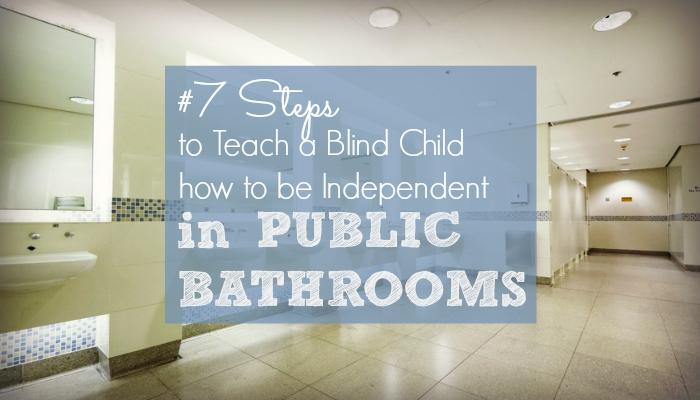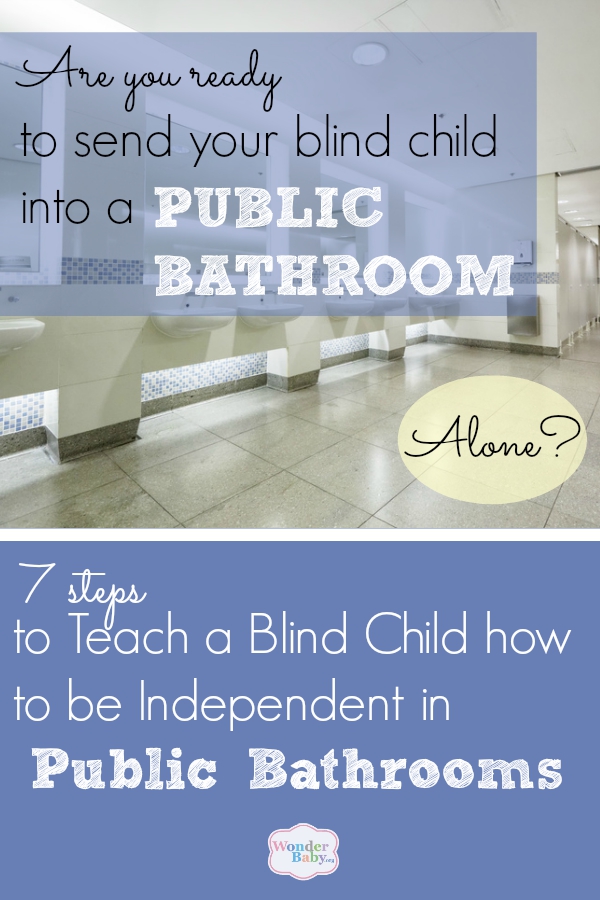7 Steps to Teach a Blind Child how to be Independent in Public Bathrooms

By Rusty Perez
Editor’s note: There is so much to consider when raising a child who is blind, but one of the biggest issues parents face is letting go. At some point you are going to want your child to be independent and the more you hold his hand, the harder that will be. Obviously many of our kids have additional disabilities that complicate independence, but for those kids who are blind without other disabilities… we’re going to have to let them move out into the world themselves. And that includes in public restrooms! After reading the article I wrote on toilet training in public bathrooms, Rusty put together some sound advice below so you can help your older children navigate bathrooms on their own as well!
When I was young, I would rather hold it than go in to a public bathroom. I was put off by the potential dirtiness and smelliness of the place, by the public nature of it, and all the unknowns worried me as well. As an adult I’ve overcome these issues and now I would much rather go than not go. But there are several strategies I employ to help the process.
First of all, let’s talk about the difficulties of navigating a public bathroom. The most obvious is its unfamiliarity. Public bathrooms are never the same. The next unknown are the potential occupants. They are moving targets, sometimes useful, but sometimes not. The last difficulty is the doubtful cleanliness.
So, here’s how I approach a trip to a public restroom….
7 Steps to Exploring a Public Bathroom
-
- #1 Use your ears to make a map. As A blind person, I walk in to a bathroom and immediately begin to puzzle out where things are. I listen carefully. Do I hear someone at the sink, at a urinal, in a stall? Any of this information can help me map out the room so I can move in the right direction.
-
- #2 It’s OK to wait a second. The dreaded sound to hear in a bathroom is several voices talking at once. This means a traffic jam or a bunch of awkward possibilities. Do they help, do they jump out of the way? Worst of all is the sound of a deafening hand air dryer. This paralyzes me, keeping me from hearing any echoes or informative sound clues. In either of these situations I either wait to hear a clear path toward where I need to be, or ask for guidance in finding my way.
-
- #3 Ask for help when you need it. If I hear urinal sounds, I make my way in that direction. I might call out casually, “Is there an open one here?” I approach the urinals listening for any clues as to where there might be a person standing. I listen for an open spot beside the other occupants and sometimes someone will give me a clue, “There’s one over here.” People are usually willing to help out, but this is delicate because I don’t want anyone to think I’m helpless, either. Worst case scenario is walking up behind a quiet urinal occupant… I’ve had to make my share of jokes and apologies after doing that! I’ve discovered that in most situations, humor is my best tool.
-
- #4 Use your cane or the back of your hand to explore. If I’ve walked into an empty bathroom, if I hear no sound, I breathe a sigh of relief and I begin exploring. I use my cane to navigate if I have it. Even though I use a dog, I have not been successful at teaching the dog how to navigate a restroom. This process is much easier with a cane since using my cane to touch a urinal or a toilet is not a problem to me. This might be the best way to teach a blind child to begin to navigate strange bathrooms. If I do not have my cane, I use the back of my hand.
-
- #5 You can also use echoes to explore.There will rarely be large open walls in a bathroom, so, if there are no humans providing sound clues I use echoes. The first thing I do is find a wall and explore. I put the cane or the back of my hand out at about waist level. If I find a sink, I remember where it is and keep moving.Often a urinal will be placed at the end of a row of sinks or beside a single sink in a small bathroom. One thing to be careful of is a small privacy wall between a sink and a urinal, or between urinals. If a stall is the objective, I listen for echoes off a wall which sounds hollow or like it doesn’t touch the ceiling and floor. I nudge each door gently to find a door which is not latched. I pray that everyone has latched their doors. When I need to use a stall I often use my feet to find the toilet, the flush handle, and even to raise the seat if that is necessary.
- #6 Clean up! By the time I am finished with my business I usually have developed a working map of the bathroom. Sometimes it’s because I’ve already found the sink, sometimes because I’ve heard others using it. If I have the forethought, I will explore above or around the sink to find a towel or soap dispenser or listen carefully as others take paper towels or soap. But, about half of the time, I find myself with wet hands in need of soap or towels. I really do not like hand blowers because they’re jarringly loud. One strategy I have not employed, but which is a good idea, is to bring my own hand sanitizer with me.
- #7 Remember the door. When I’m ready to leave I find the door. Usually my dog is ready to go by this point, so a command to “find the door” or “let’s go” will do the trick. If you don’t have a dog, be sure to make note of the placement of the door when you enter the room so you don’t get turned around when it’s time to leave.
The public bathroom can be an intimidating place. The large space or the presence of many people can make it even more so, but with a few strategies, it’s possible to do what’s got to be done independently!
Blind since birth with Retinitis Pigmentosa, Rusty has been a high school and college English teacher, a professional Spanish interpreter, and semi-professional musician. Wishing to use his experience to educate others in the area of disability, he has begun writing. He lives with his wife and furry children and step children in Southern California. If you have any questions contact rusty at Rusty.Perez@gmail.com or listen to his music at www.RustyPerez.com

Related Posts

Eye Conditions and Syndromes, Visual Impairment
Neuralink Announces Plans to Restore Sight to the Blind with Brain Chip
Elon Musk’s company Neuralink has announced plans to begin human trials of its new “Blindsight” brain chip by the end of 2025.

Visual Impairment
The Gift of Understanding: How a Young Child Helps His Blind Father Navigate Life
When a parent is blind, it’s natural for people to wonder how their sighted child will adapt. Will they struggle to understand their parent’s needs? Will they feel burdened by...

Braille and Literacy, Toys, Visual Impairment
24 Braille Toys for Kids Who are Blind
Everything from alphabet blocks to raised line coloring pages and activity books to puzzles to card and board games... and so much more! And it's all in braille ready for...